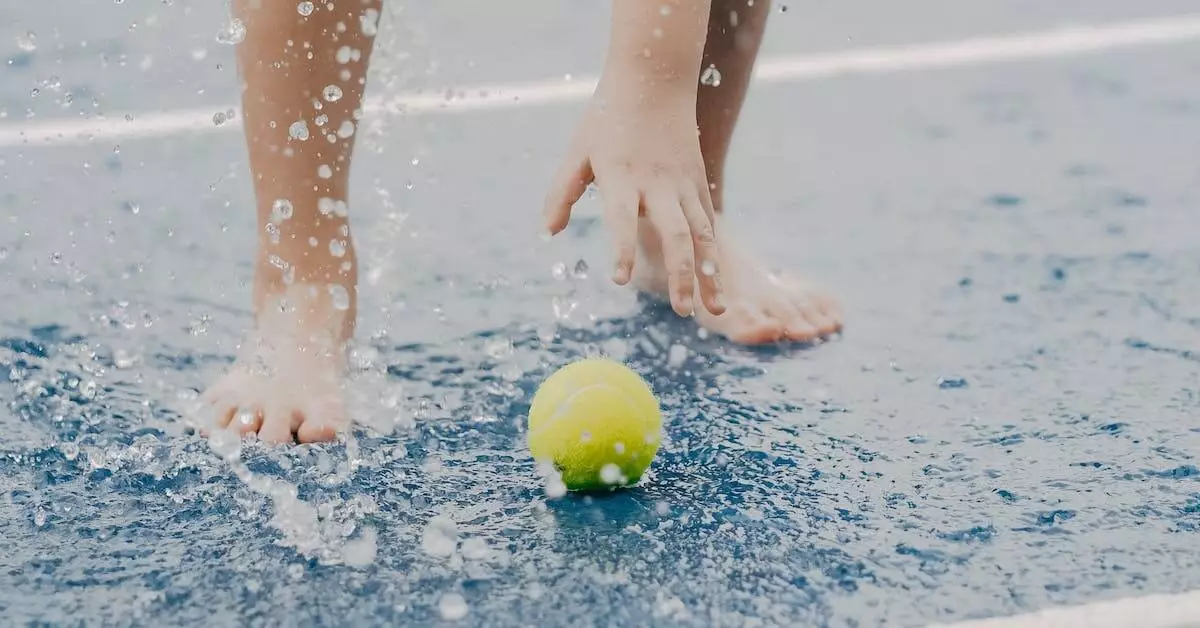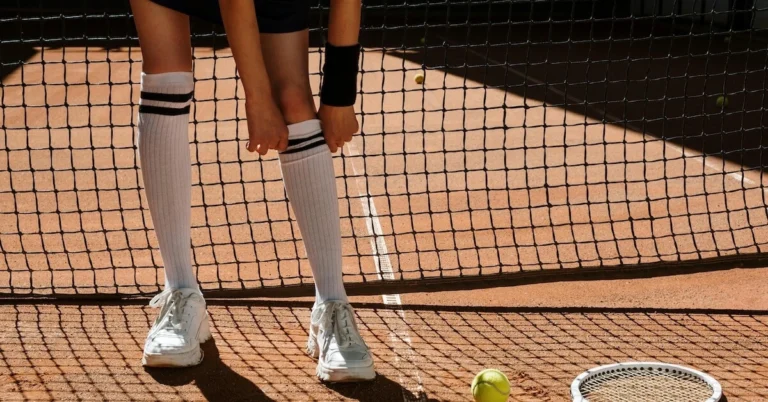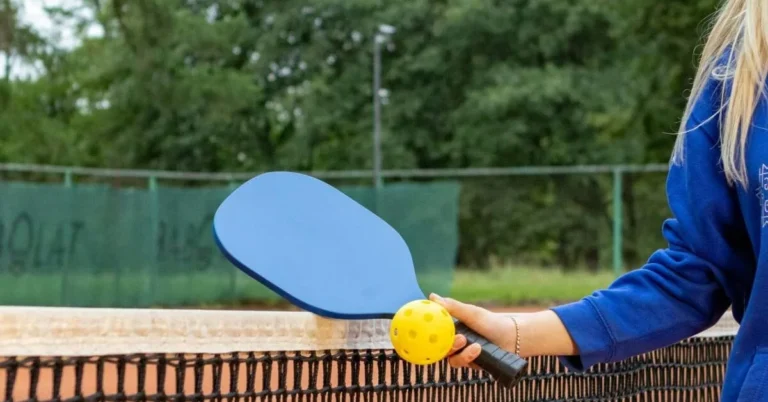As tennis aficionados, we cherish our time on the court, but what happens when the skies decide to open up? “Can You Play Tennis in the Rain?” is a question that has sparked many a debate among tennis enthusiasts. Some may say it’s a washout, while others believe the game must go on, rain or shine.
Join me as we serve up some insights, sprinkle in a bit of humor, and explore the possibilities of keeping the game afloat even when the raindrops start to fall. From the practical considerations to the unexpected benefits, let’s navigate through the mist and uncover the truth about playing tennis in the rain. So grab your umbrella and let’s step onto the court, rain or shine!
Understanding Tennis and Weather Conditions
When it comes to playing tennis, weather conditions can play a significant role in determining whether or not you can play. Rain is one of the most common weather conditions that can affect tennis players. If you’re wondering whether you can play tennis in the rain, the answer is yes, you can. However, there are some things you need to consider before you hit the court.
One of the first things you need to do is to check the weather forecast. This will help you determine whether or not it’s safe to play tennis in the rain. If the forecast calls for heavy rain or thunderstorms, it’s best to stay off the court. Playing tennis in these conditions can be dangerous and increase the risk of injury.
If the rain is light, you can still play tennis, but you need to take some precautions. You should wear proper rain gear to keep yourself dry and warm. This includes a waterproof jacket, pants, and shoes. You should also bring a towel to dry off your racket and balls.
Another thing to consider is the condition of the court. If the court is wet, it can be slippery, making it difficult to move around and increasing the risk of injury. You should also be aware that playing tennis in the rain can damage the court, especially if it’s a clay court. Wet clay can become slippery and affect the bounce of the ball.
The Impact of Rain on Different Court Surfaces
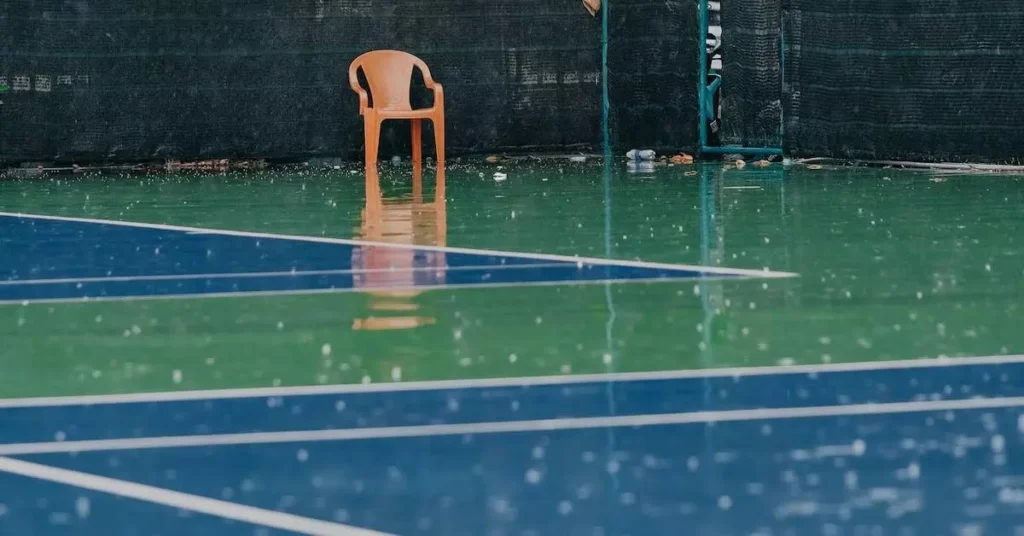
When it comes to playing tennis in the rain, the condition of the court surface plays a crucial role. Different court surfaces react differently to rain, and it’s essential to understand how each surface can affect your gameplay. Here’s a breakdown of how rain can impact different court surfaces.
Clay Courts
Clay courts are particularly susceptible to the effects of rain. When it rains, water is absorbed by the clay, making the surface soft, slippery, and muddy. This not only makes the court hazardous for players, risking slips and falls, but also affects the bounce and speed of the ball. Playing on a wet clay court can be challenging, as the ball tends to skid and slide, making it difficult to control your shots. If you’re playing on a clay court and it starts to rain, it’s best to stop playing and wait for the court to dry out.
Grass Courts
Grass courts can also be affected by rain, but they tend to drain water more quickly than clay courts. However, if the rain is heavy, and the court has not been adequately maintained, it can lead to puddles forming on the surface. Puddles can make the surface slippery and dangerous for players, increasing the risk of injury. If you’re playing on a grass court and it starts to rain, it’s best to stop playing and wait for the court to dry out.
Hard Courts
Hard courts are the most common type of tennis court, and they are relatively unaffected by rain. However, if the court has not been adequately maintained, it can lead to water pooling on the surface, making it slippery and dangerous for players. If you’re playing on a hard court and it starts to rain, it’s best to stop playing and wait for the court to dry out.
Safety Considerations While Playing Tennis in the Rain
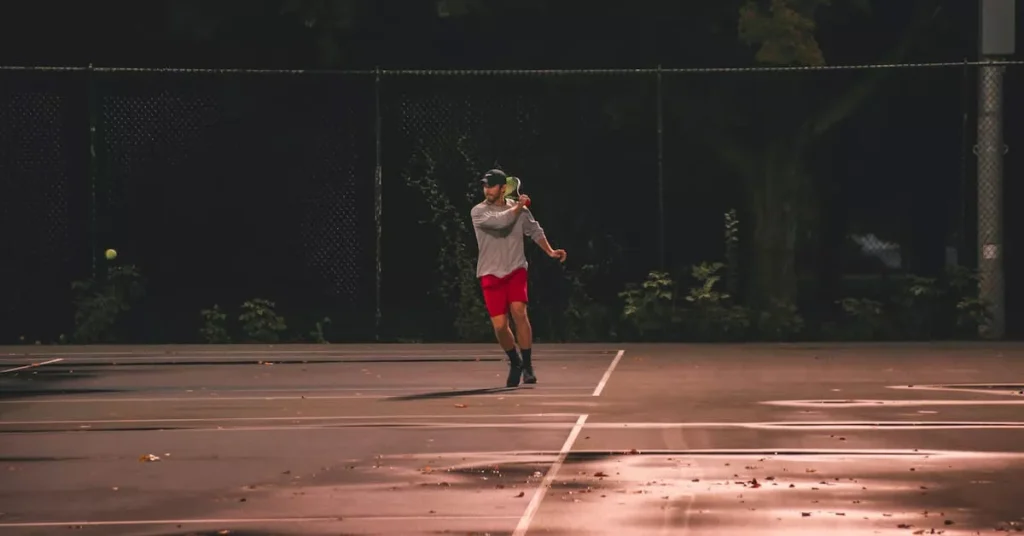
Playing tennis in the rain can be a thrilling and challenging experience. However, it is important to exercise caution and take certain precautionary measures to ensure your safety and avoid injuries.
Risk of Injuries
Playing tennis in wet conditions can increase the risk of slip and fall injuries. Wet court surfaces can become slippery, making it difficult to maintain balance and movement. This can lead to falls, which can cause injuries to various parts of the body, including knees, elbows, and wrists.
Precautionary Measures
To reduce the risk of injuries while playing tennis in the rain, it is important to take certain precautionary measures. Here are some tips:
- Wear non-slip shoes with good traction to improve stability and reduce the risk of slipping.
- Use a grip enhancer to maintain a firm grip on the racket and prevent it from slipping out of your hand.
- Stay alert and cautious while playing. Be aware of your surroundings and avoid sudden movements that can cause you to lose balance.
- Take breaks as needed to rest and recover. Playing in wet conditions can be physically demanding and tiring, so it is important to listen to your body and take breaks when necessary.
- If the rain becomes too heavy or the court becomes too slippery, consider calling off the game. It is better to be safe than sorry.
By following these precautionary measures, you can reduce the risk of injuries and enjoy playing tennis in the rain safely.
Suitable Equipment for Playing Tennis in the Rain
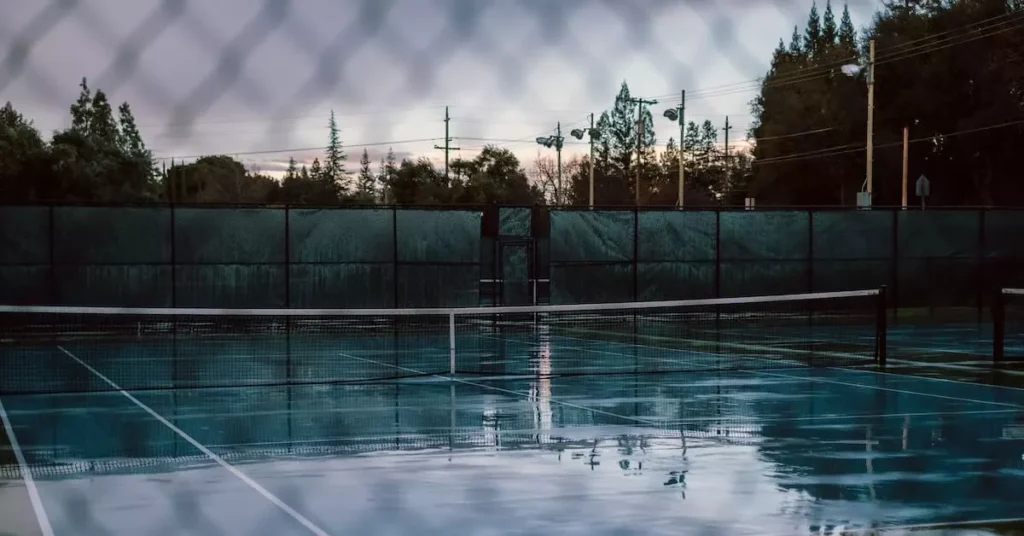
When playing tennis in the rain, it is crucial to have the right equipment to ensure safety, comfort, and optimal performance.
| Footwear | One of the most important pieces of equipment for playing tennis in the rain is footwear. You need shoes with good grip and traction to prevent slipping and sliding on the wet court. Tennis shoes are designed to provide excellent grip and stability, making them a great choice for playing in the rain. Make sure your shoes fit well and are comfortable to wear for extended periods. |
| Rackets | Your racket is also an essential piece of equipment when playing tennis in the rain. Look for a racket with a good grip, such as one with an over-grip that provides extra traction and prevents slipping. Avoid using rackets with worn-out handles, as they can become slippery when wet. Additionally, wipe down your racket with a towel after playing to prevent rust and damage. |
| Balls | Tennis balls can become heavy and waterlogged in the rain, affecting their bounce and making them harder to hit. Consider using special rain-resistant tennis balls that are designed to repel water and maintain their bounce. Alternatively, keep a few extra dry balls on hand to switch out as needed. |
| Additional Gear | Other essential gear for playing tennis in the rain includes a cap or hat to keep rain out of your eyes, a towel to dry off your equipment and hands, and rain gear such as a waterproof jacket or pants to keep you dry. Make sure your gear is comfortable and fits well to avoid hindering your movement on the court. |
Adapting Your Play Style for Wet Conditions
Playing tennis in the rain can be challenging. The game becomes slower, and the ball bounces lower, making it harder to hit. However, with the right approach, you can still enjoy the game and get a good workout. Here are some tips to help you adapt your play style for wet conditions.
Serving in the Rain
Serving in the rain can be tricky. The ball can slip out of your hand, and your racket can become wet, making it harder to control your serve. To compensate for this, you can try using a kick serve. A kick serve involves hitting the ball with topspin, causing it to bounce higher and making it harder for your opponent to return. This type of serve can be especially effective in wet conditions.
Footwork and Movement
Footwork is crucial when playing in the rain. You need to be focused and maintain stability to avoid slipping on the wet court. To improve your footwork, try to bend your knees slightly and take shorter steps. This will help you maintain your balance and stability. Additionally, you can try to move more deliberately, avoiding sudden changes of direction which can cause you to lose your footing.
Volley Game and Swing
The volley game and swing are also affected by wet conditions. The ball bounces lower, and it can be harder to generate power. To compensate for this, try to focus on your timing and technique. Keep your racket head up and hit through the ball, rather than just making contact. Additionally, you can try to use more spin to generate more power and control.
Major Tournaments and Rain
When it comes to major tennis tournaments, rain can be a significant issue. Wimbledon, one of the most prestigious tennis tournaments globally, is often affected by rain. In 1997, the wettest year on record, 118.3mm of rain was recorded during the tournament. During Wimbledon, the All England Lawn Tennis and Croquet Club has a policy of closing the roof on Centre Court and No. 1 Court when it rains. This allows play to continue on these two main courts, even during rainy weather. However, the outer courts have no such protection, and rain can cause significant delays and even cancellations.
The US Open also has a history of rain delays and cancellations. In 2011, the men’s final was delayed until Monday due to rain, and the women’s final was moved to Sunday night to avoid a similar delay. The tournament now has a retractable roof on Arthur Ashe Stadium, which can be closed during rain to allow play to continue.
Indoor courts are not affected by rain, but they do have their own challenges. Playing on an indoor tennis court can be a very different experience from playing on an outdoor court. The surface is usually faster, and the ball bounces lower, which can take some getting used to. However, indoor courts are not affected by weather conditions, and play can continue regardless of rain or wind.
Fun and Challenges of Playing Tennis in the Rain
Playing tennis in the rain can be a fun and challenging experience. It can provide a unique opportunity to practice mental toughness, improve hand-eye coordination, and enhance endurance and physical fitness. However, it is important to take certain precautions to ensure safety and prevent injury.
One of the most significant challenges of playing tennis in wet conditions is the effect it has on the ball and the court. When the court is wet, the ball bounces differently, making it more difficult to predict its trajectory and adjust your shots accordingly. This can add an extra level of challenge to the game and make it more exciting.
Another challenge of playing tennis in the rain is the increased risk of slipping and falling. Wet courts can be slippery, which can lead to injuries such as sprains or even broken bones. To prevent this, it is important to wear appropriate shoes with good traction and to be cautious when moving around the court.
Despite the challenges, playing tennis in the rain can be a lot of fun. The sound of raindrops hitting the court can create a soothing and relaxing atmosphere, and the unique conditions can make for a memorable and enjoyable game. It can also be a great way to bond with friends or family members who share your love of the game.
6 Tips for Playing Tennis in the Rain
Playing tennis in the rain can be a challenging and fun experience. However, it is essential to take some precautions to ensure your safety and to avoid any injuries. Here are some tips for playing tennis in the rain:
1. Wear Appropriate Clothing
Wearing the right clothing is essential when playing tennis in the rain. You should wear clothes that will keep you dry and comfortable. Choose clothing made of moisture-wicking fabric that will draw sweat away from your body. Also, wear a lightweight rain jacket to keep you dry.
2. Use the Right Footwear
Wearing the right shoes is crucial when playing tennis in the rain. You need shoes with good traction to prevent slipping. Use tennis shoes with a non-slip sole that will provide you with the necessary grip on the court.
3. Modify Your Footwork
Adjust your footwork when playing on a wet court. Take smaller steps and turn more slowly to avoid slipping. Be cautious when making sudden stops or direction changes that could cause you to lose balance.
4. Adjust Your Shots
Playing in the rain requires some adjustments to your shots. Hitting with topspin will make the ball bounce higher, and hitting with slice will make the ball stay lower. Using slice shots can be especially effective when playing in the rain because it helps to minimize the acceleration towards the net.
5. Keep Your Equipment Dry
You need to keep your equipment dry when playing tennis in the rain. Use a waterproof bag to store your tennis racquets, balls, and other equipment. Also, use a towel to dry your equipment whenever it gets wet.
6. Check the Weather Forecast
Before heading to the court, check the weather forecast to ensure that it is safe to play. Avoid playing during a thunderstorm or heavy rain. If the court is too wet, consider postponing your game until the rain stops.
FAQ
Is it safe to play tennis in the rain?
Playing tennis in the rain can be dangerous as it increases the risk of slipping and falling on the court. However, if you take the necessary precautions, playing tennis in the rain can be safe. Make sure to wear appropriate shoes with good traction, avoid sudden movements, and adjust your playing style to the wet conditions. If the rain is too heavy or if there is lightning, it is best to stop playing and seek shelter immediately.
How do wet weather tennis balls differ from regular ones?
Wet weather tennis balls are designed to be more visible and have better performance in wet conditions. They are made of materials that repel water and have a brighter color to make them more visible in low light conditions. The felt on the ball is also designed to be more durable and less likely to absorb water. This helps to maintain the ball’s bounce and performance even in wet conditions.
What types of tennis courts are best for playing in the rain?
Hard courts and artificial grass courts are the best types of tennis courts for playing in the rain. These courts have a more even surface with good drainage, which helps to prevent puddles from forming on the court. However, it is still important to take precautions when playing on these courts in wet conditions.
Can you play on clay tennis courts after it rains?
It is not recommended to play on clay tennis courts after it rains. Clay courts are more susceptible to damage from water and can become slippery and dangerous to play on. It is best to wait until the court has dried completely before playing on it again. If you must play on a clay court in wet conditions, make sure to use appropriate shoes and adjust your playing style to the conditions.
The age-old question of playing tennis in the rain has been served with a side of humor and insight. Whether you’re dodging raindrops with a swift backhand or contemplating the physics of a soggy tennis ball, there’s no denying that rain adds an unexpected twist to the game we love.
So, what’s your take on this watery conundrum? Have you experienced any comical rain-soaked rallies on the court, or perhaps you have your own quirky rain-ready tennis tips to share? We’d love to hear your thoughts, anecdotes, or even your wittiest rain-related tennis puns in the comments below!

